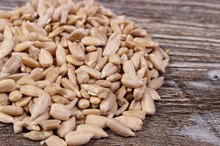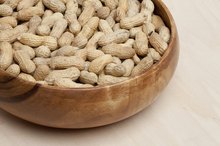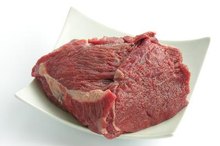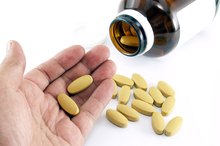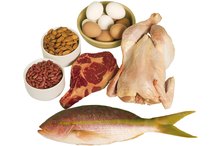What does fact checked mean?
At Healthfully, we strive to deliver objective content that is accurate and up-to-date. Our team periodically reviews articles in order to ensure content quality. The sources cited below consist of evidence from peer-reviewed journals, prominent medical organizations, academic associations, and government data.
The information contained on this site is for informational purposes only, and should not be used as a substitute for the advice of a professional health care provider. Please check with the appropriate physician regarding health questions and concerns. Although we strive to deliver accurate and up-to-date information, no guarantee to that effect is made.
Food Sources of Niacinamide
The body makes niacinamide from niacin in the diet. They are both considered to be forms of vitamin B3. This vitamin helps the body convert carbohydrates into fuel for energy, explains the University of Maryland Medical Center, or UMMC 2. Adult women need 14 mg each day, while adult men require 16 mg, according to the Linus Pauling Institute. Pregnant and breastfeeding women have a larger daily requirement. Vitamin B3 deficiency is rare in the United States due to the widespread availability of foods containing niacin. An amino acid, tryptophan, also becomes niacinamide in the body.
Proteins
Fish, such as swordfish, salmon and tuna, are good sources of vitamin B3. The white meat of poultry, such as turkey and chicken, provide high amounts of the vitamin. Organ meats including beef kidney and beef liver also contribute. Eggs and milk products are beneficial sources, explains the UMMC.
- Fish, such as swordfish, salmon and tuna, are good sources of vitamin B3.
- The white meat of poultry, such as turkey and chicken, provide high amounts of the vitamin.
Vegetables and Legumes
Vitamin C in Mangoes
Learn More
Beets and green vegetables contain vitamin B3. The vitamin is also found in corn, but it is in a form that is difficult for the body to use. Legumes, such as lentils, lima beans and peanuts, are generally better sources than corn products.
Grains
Wheat and unfortified cereals contribute a small amount of vitamin B3 to the diet but fortified cereals and breads are considered better sources. All forms of fortified pasta, such as spaghetti noodles and macaroni, provide a small amount of this nutrient as well.
Other Foods
Anemia & Vitamin K
Learn More
Yeast, especially Brewer's yeast, is a good source of vitamin B3. Sunflower seeds also contribute to the body's daily requirement.
Considerations
Some individuals take niacin supplements to reduce high blood cholesterol. This should be done only under the guidance of a physician as some over-the-counter niacin products have severe side effects. High doses of niacin taken without physician supervision can also produce adverse effects. The Mayo Clinic recommends regular liver function tests while taking niacin as liver damage is possible.
- Some individuals take niacin supplements to reduce high blood cholesterol.
- The Mayo Clinic recommends regular liver function tests while taking niacin as liver damage is possible.
Related Articles
References
- Oregon State University: Linus Pauling Institute: Niacin
- University of Maryland Medical Center: Vitamin B3
- Blair KA. Vitamin supplementation and megadoses. Nurse Pract. 1986;11(7):19-26, 31-6.
- National Institutes of Health, Office of Dietary Supplements,.Vitamin A. NIH Office of Dietary Supplements.
- Ferraro PM, Curhan GC, Gambaro G, Taylor EN. Total, Dietary, and Supplemental Vitamin C Intake and Risk of Incident Kidney Stones. Am J Kidney Dis. 2016;67(3):400–407. doi:10.1053/j.ajkd.2015.09.005
- Nair R, Maseeh A. Vitamin D: The "sunshine" vitamin. J Pharmacol Pharmacother. 2012;3(2):118–126. doi:10.4103/0976-500X.95
- NIH Office of Dietary Supplements (ODS). Office of Dietary Supplements - Niacin. National Institutes of Health.
- Koyanagi T, Hareyama S, Kikuchi R, Takanohashi T, Oikawa K. Effect of administration of thiamine, riboflavin, ascorbic acid and vitamin A to students on their pantothenic acid contents in serum and urine. Tohoku J Exp Med. 1969;98(4):357-62. doi: 10.1620/tjem.98.357
- National Institutes of Health Office of Dietary Supplements. "Folate Dietary Supplement Fact Sheet." Updated April 20, 2016.
- National Institutes of Health Office of Dietary Supplements. "Vitamin A Fact Sheet for Health Professionals." Updated August 31, 2016.
- National Institutes of Health Office of Dietary Supplements. "Vitamin C Fact Sheet for Health Professionals." Updated February 11, 2016.
- National Institutes of Health Office of Dietary Supplements. "Vitamin D Fact Sheet for Health Professionals." Updated February 11, 2016.
- National Institutes of Health Office of Dietary Supplements. "Vitamin E Fact Sheet for Health Professionals." Updated August 31, 2016.
Writer Bio
J. Lucy Boyd, RN, BSN has written several nonfiction books including "The Complete Guide to Healthy Cooking and Nutrition for College Students." She is frequently called upon to provide career guidance to medical professionals and advice to parents of children with challenges. She also loves teaching others to cook for their families.



